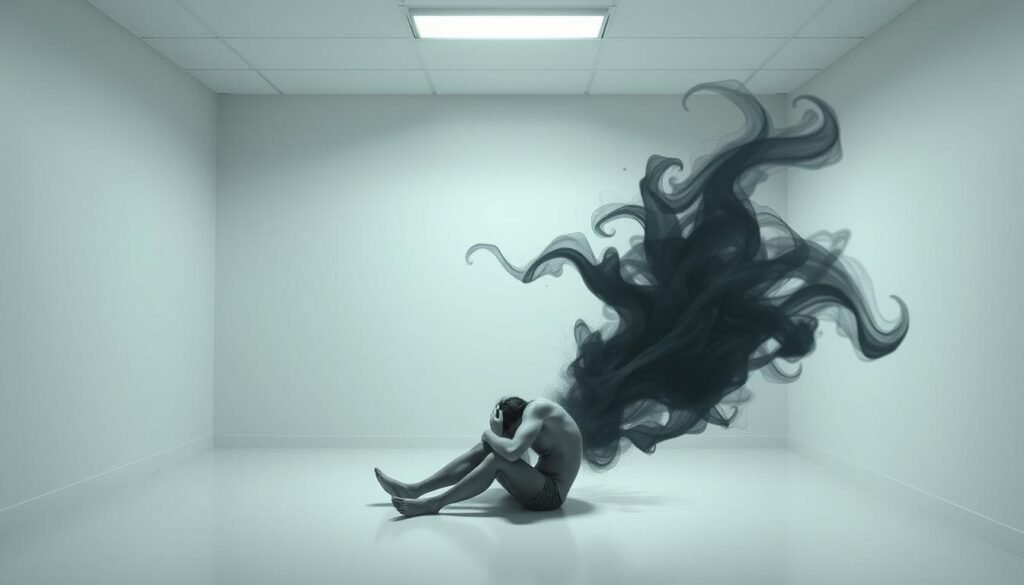Zac Efron and Sami Miró stepped out together on Thursday, when they sweetened their week…
Read More →

Zac Efron and Sami Miró stepped out together on Thursday, when they sweetened their week…
Read More →
To say we’re more obsessed with bareMinerals’ founder Leslie Blodgett than we are with the…
Read More →
Supermodels who have babies, and the next week they look as if they were never…
Read More →
As events continue to unfold following the devastating earthquake in Nepal over the weekend, there…
Read More →
Wet-to-dry eye shadows need not be complicated. While it might sound like yet another technique…
Read More →White room torture is a chilling way to manipulate someone’s mind. It tests how much a person can handle mentally. This method uses empty spaces and control over senses to break someone’s mind.
This torture is different from physical harm. It uses emptiness and control over senses. People are put in white rooms with no context. This makes them feel lost and challenges their way of thinking.
Experts say white room torture is very harmful. It breaks down a person’s mental defenses. By removing all outside stimuli, it attacks the heart of human psychology.
White room torture is a new form of psychological warfare. It’s a way to break a person’s will by depriving them of their senses. This method is more advanced than old interrogation ways.
This dark method started in the mid-20th century. It grew during the Cold War. The CIA led many experiments to see how much humans could take.
Psychological warfare has always tried to find human weaknesses. White room torture came from studies on:
“The mind is the ultimate battlefield where true psychological warfare unfolds.” – Unknown Intelligence Researcher
Techniques for removing senses got more advanced over time. Agencies learned how to affect the brain deeply. They found out how changing the environment can impact our minds.
| Decade | Key Developments | Research Focus |
|---|---|---|
| 1950s | Initial Sensory Isolation Experiments | Cognitive Response Mapping |
| 1960s | CIA MK-Ultra Program | Advanced Psychological Manipulation |
| 1970s | Refined Interrogation Techniques | Mental Breakdown Strategies |
White room torture marks a dark point in studying human weakness. It makes us question the limits of questioning and human rights.
White room torture is a complex way to mess with someone’s mind. It takes away the basic need for sensory input. This method affects more than just physical pain, reaching deep into how we think.
This torture works by messing with how we think. Without normal senses, people’s minds get really confused. This can make someone’s mental strength start to crumble.
“The mind cannot sustain itself in absolute emptiness” – Neuropsychological Research Institute
Studies show that being alone for too long is very stressful for the brain. Without outside help, the brain starts making up its own stories. Mental manipulation through environmental control becomes a powerful psychological weapon.
| Psychological Response | Typical Duration | Intensity Level |
|---|---|---|
| Initial Disorientation | 12-24 hours | Moderate |
| Cognitive Breakdown | 48-72 hours | Severe |
| Mental Fragmentation | 72+ hours | Critical |
The clever thing about white room torture is how it uses our weakness against us. By taking away all outside clues, it makes our own minds our biggest enemy.
The design of torture chambers is a careful plan to control minds. These rooms are made to weaken people through control of their environment.
Experts in psychological warfare know the power of the physical space. They design these areas to affect people’s senses deeply.
Modern torture chambers use advanced sound-proofing. This creates a space where no sound can get in. Key features include:
Controlling the environment is a powerful tool. Changing the temperature can make people uncomfortable and confused.
| Environmental Factor | Psychological Impact |
|---|---|
| Extreme Cold | Induces physical stress and mental confusion |
| Extreme Heat | Causes cognitive impairment and disorientation |
| Humidity Control | Increases psychological vulnerability |
Isolation rooms are designed to confuse and break people. The minimalist white environment removes all spatial and sensory anchors, making people feel detached from reality.
“The room itself becomes a weapon of psychological destruction” – Human Rights Expert
These environments show a dark mix of architecture and human weakness.
White room torture is a unique and devastating form of psychological manipulation. It goes beyond traditional physical torture. This method targets the mind with great precision, causing deep psychological trauma.
When comparing psychological vs. physical torture, we see key differences:
The severity of white room torture comes from its design. It removes all sensory input, causing a kind of mental breakdown. This is something physical torture can’t do.
“The most devastating weapon is the one that breaks the mind without leaving a trace.” – Human Rights Researcher
| Torture Type | Psychological Impact | Recovery Potencial |
|---|---|---|
| Physical Torture | Moderate to Severe | Potentially Manageable |
| White Room Torture | Extremely Severe | Extremely Challenging |
The long-term effects of white room torture are severe. They include permanent cognitive disruption and sensory processing disorders. Victims often have trouble rebuilding their sense of reality even after they physically recover.
Experts see white room torture as a powerful psychological weapon. It uses sensory elimination to break down a person’s mental strength.
The study of torture shows big changes in brain function when there’s no sensory input. White room torture messes with brain processes, leading to big changes in thinking and brain chemistry.
Long-term isolation changes brain chemistry a lot. Research shows big shifts in brain function:
Neural plasticity gets hurt a lot during long sensory deprivation. This leads to big problems with thinking, caused by deep changes in the brain.
| Neural Domain | Observed Changes | Potential Outcomes |
|---|---|---|
| Prefrontal Cortex | Reduced neural connectivity | Decision-making difficulties |
| Hippocampus | Decreased neurogenesis | Memory impairment |
| Amygdala | Hyperactive stress response | Emotional dysregulation |
“The brain’s response to sensory deprivation represents a profound neurological adaptation mechanism with potentially devastating consequences.” – Dr. Elizabeth Stern, Neuropsychology Research Institute
Knowing these effects shows how bad white room torture is for the mind.

White room torture causes deep psychological harm that goes beyond just being locked up. It leads to severe mental health issues, with PTSD being a major long-term effect. The lack of sensory input changes how the brain works in big ways.
The mental health impacts include:
Studies show survivors often face many psychological problems at once. The brain’s ability to change makes it vulnerable to extreme stress. This leads to long-lasting mental health issues.
“Sensory deprivation doesn’t just impact the mind—it fundamentally rewrites psychological landscapes.” – Dr. Elena Rodriguez, Trauma Psychologist
Brain scans show big changes in brain chemistry and pathways. The effects on mental health can last for years or even a lifetime. Some survivors may never fully recover.
| Psychological Condition | Prevalence Among Survivors | Potential Long-Term Impact |
|---|---|---|
| PTSD | 78% | Chronic psychological instability |
| Anxiety Disorders | 85% | Persistent social interaction difficulties |
| Depression | 72% | Potential treatment-resistant symptoms |
It’s key to understand these effects to help survivors recover. We need to support them through their long journey back to health.
White room torture warps time in a way that’s hard to grasp. It makes victims lose track of time, feeling like it’s always changing.
White rooms are designed to mess with our natural time sense. They remove all signs of time, making it hard to keep track of reality.
Circadian rhythm disruption happens in a few ways:
Victims feel time stretching out in weird ways. Minutes seem like hours, and hours like days. This makes their internal clock break down, leading to a dreamlike state.
“Time becomes an abstract concept, detached from reality and personal experience.” – Psychological Trauma Research Institute
| Time Perception Stage | Psychological Impact |
|---|---|
| Initial Disorientation | Confusion and anxiety |
| Prolonged Exposure | Complete temporal detachment |
| Advanced Disorientation | Cognitive fragmentation |
The white room environment attacks our sense of time. It’s a powerful tool that goes beyond usual interrogation methods.
White room torture cases show a pattern of psychological control worldwide. Survivors tell stories of deep mental harm from this method.
Historical records show where white room torture started:
“The white room breaks you without leaving a single physical mark” – Anonymous torture survivor
Survivors often share similar experiences, like:
Studies show white room torture is well-documented in human rights reports. These reports show the lasting mental damage from such torture.
Human rights groups have detailed records of these practices. Their work gives us a deep look into the harm caused by these methods.
Torture laws face a big challenge in dealing with psychological tricks like white room torture. It’s hard for international law to fully define and punish these serious human rights abuses.

White room torture is in a gray area of the law. It pushes the limits of what international human rights laws cover. The Geneva Conventions offer important rules, but it’s hard to pin down these psychological torture methods legally.
The Geneva Conventions say no to torture, but dealing with psychological torture is tricky. Key points include:
Today, lawyers and experts are arguing over what counts as psychological torture under international law. The main issues are:
| Legal Challenge | Specific Concern |
|---|---|
| Evidence Collection | Invisible psychological damage |
| Prosecutorial Standards | Proving intentional psychological harm |
| International Jurisdiction | Cross-border accountability |
“The absence of physical marks does not diminish the profound human rights violations inherent in psychological torture.” – International Human Rights Commission
Legal systems are getting better at handling these complex human rights issues. They now see that psychological harm can be just as bad as physical harm.
Survivors of white room torture face big challenges in their minds. They need special help to heal. This help must tackle the unique effects of being cut off from the world.
Rebuilding their lives is key. Reintegration programs help a lot. They focus on several important areas:
Mental health experts use special strategies to help. Trauma recovery is not linear. It needs time, care tailored to each person, and a whole approach to healing.
“Rehabilitation is about reclaiming identity and restoring hope after unimaginable psychological damage.” – International Trauma Experts Consortium
Support programs bring together many experts. They include psychologists, neurologists, social workers, and more. Together, they make plans that meet each survivor’s needs.
When torture rehabilitation works, survivors can start to feel like themselves again. They can rebuild trust and join their communities with strength and hope.
Torture prevention is a big challenge worldwide. It needs strong strategies and watchful eyes from around the globe. Governments and human rights groups work hard to find and stop psychological abuse in detention centers.
Creating accountability is key. International groups make detailed plans to spot and stop psychological torture early on.
| Prevention Method | Primary Focus | Implementation Level |
|---|---|---|
| Independent Inspections | Detect Abuse Patterns | International |
| Staff Training | Ethical Conduct | Institutional |
| Legal Framework | Prosecution Prevention | Governmental |
“Prevention is always more effective than intervention in human rights protection.” – UN Human Rights Commission
International oversight must keep up with new changes. New tech and advanced monitoring help make detention centers safer. This protects basic human rights.
White room torture is a severe attack on human dignity, showing the darkest side of psychological torture. It destroys mental strength through isolation, making us question human limits and what’s right in interrogation.
Human rights groups are key in fighting these cruel methods. They help by spreading the word about torture, pushing for fair interrogation practices. This way, they ensure respect for human rights and follow global laws.
The effects of white room torture on the mind and brain are lasting. Survivors need special care to recover their mental health and regain control over their lives. This shows the need for thorough help programs.
We must keep working to protect human rights and stop these cruel practices. By staying committed to justice and caring for each other, we can prevent such horrors in the future.
